How a team of curators and designers at the V&A successfully built a video game exhibition that practises what it preaches
How Videogames: Design/Play/Disrupt overcame the challenge of communicating what video games are in a physical space
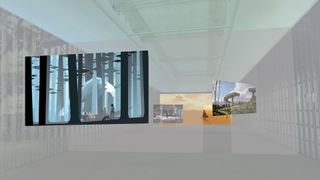
Making a museum exhibition, it turns out, can be a lot like making a video game. That’s certainly been the case with Videogames: Design/Play/Disrupt. Showing at the Victoria And Albert Museum in London from now until February 24, 2019 and headed up by Design, Architecture and Digital department curators Marie Foulston and Kristian Volsing, it takes a close look at the medium’s growth over the last 15 years into one of the most innovative, disruptive and pervasive design disciplines ever. “In the mid-2000s, there was a whole host of technological catalysts which radically impacted the way that games are designed, discussed, and played,” Foulston says, pointing to developments such as broadband, smartphones and social media. “That whole period was not just about game design or digital design; it’s had a huge impact across society and design. And that is a really urgent design story to tell.”
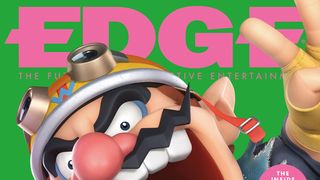
Subscribe to Edge Magazine in print or digital for more in-depth features, reviews and interviews about the future of interactive entertainment.
And it is one that’s never before been told at the V&A in this much depth, a carefully constructed journey presenting everything from original prototypes, concept-art sketchbooks, immersive audiovisual installations and interactive media. Simply figuring out to convey such a broad medium faithfully and effectively has been a challenge: how do you begin to talk about something for which you don’t even have a curatorial language? The answer, it soon transpired, was hidden within the subject matter itself. Design/Play/Disrupt stands self-evident: the space itself has been heavily influenced by its creators’ research into game design, and their realisation of how useful these digital worlds might prove in building a new kind of immersive, interactive experience. Whether you’re familiar with video games or not, the beauty of this new exhibition is that simply walking through it is enough to tell you everything you need to know about the ubiquitous nature of contemporary game design.
How did the exhibition come to life?
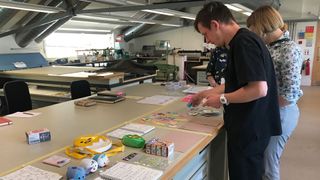
The origin of the exhibition predated both Foulston and Volsing’s involvement. Kieran Long established the V&A’s department of architecture, design and digital back in 2013, becoming keeper of the department in 2014. ”He’s somebody who comes from architectural background but grew up with video games,” Foulston says. “He understands the value of them. When he started at the museum he said, ‘This is a critical part of contemporary design, and we have to be engaging with it.’”
Not that the V&A hasn’t opened its doors to video games before: Flappy Bird was part of the museum’s Rapid Response collection (which sees curators seeking out more recent objects, of note for their cultural or creative significance) that Foulston has previously worked on; likewise, the V&A Museum Of Childhood features video games in its permanent collection, and temporary exhibitions such as Disobedient Objects and British Design have included them.

But Design/Play/Disrupt is certainly the largest and most in-depth engagement the institution has had with the discipline. Previous digital design curator Louise Shannon and video game consultant (and former Edge editor) Alex Wiltshire worked on the early proposals and did much of the internal lobbying for the exhibition, Foulston says. Soon after, she and Volsing came aboard to redefine the scope of the exhibition, working alongside the senior curator of design and digital, Corinna Gardner. “Rapid Response is sort of her project,” Foulston says, “and there are a lot of learnings that this exhibition has taken from the work we’ve done on that. It’s been great to develop this exhibition within a department that connects not just with digital, but with design, and with architecture as well. There’s so much we’ve learned from being in a space which connects video games to those other disciplines.”
"Making a game combines everything that’s hard about building a bridge and everything that’s hard about composing an opera."
Frank Lantz, Game Designer
Indeed, when we talk about the future of interactive entertainment, we’re doing so in the context of a medium that is composed of several others: film, art, music, engineering, and so on. Foulston points to a quote from game designer Frank Lantz that helped summarise the thematic tension present during the early days of the exhibition: “Making a game combines everything that’s hard about building a bridge and everything that’s hard about composing an opera. Games are operas made out of bridges.”
How do you make video games work as an interactive exhibit?

Curating an exhibition that can effectively communicate what video games are, and can be, was a challenge. “Video games are a time-bound and an interactive medium, and both of those things make it an incredibly complex medium to show in a public space,” Foulston says. Shoving an array of consoles into a room and telling people to get stuck in wasn’t going to cut it. “A game can sometimes take upwards of 60 hours to play to really allow somebody to visualise it, or to understand it as a design object. And so for us the question, and the work we’ve been doing, is: how do we define a new curatorial language for video games that exposes that design?
Sign up to the GamesRadar+ Newsletter
Weekly digests, tales from the communities you love, and more
“You get a sense of vertigo,” she continues. “Anybody working in culture and institutions working across video games feels that, because there are still not a lot of exhibitions or installations that engage with this subject matter. So you feel this sense of, oh my god, how do we do everything? And you can’t.” What she could do was take a few deep breaths, buy a few big boards, start sticking up pictures of things she was interested in and see where it led. “And that’s kind of the way it starts. Every curator, when they come to a project, they bring their own perspective: thinking, ‘Okay, what is it that’s interesting to you, and how do we find a structure or narrative through that?’”

The idea was to examine video games through the very V&A lens of the design process itself. This would be the guiding thread through the exhibition, and would serve multiple purposes: fitting with the V&A’s remit, offering new and valuable insights to those with an in-depth knowledge of games, and inspiring those without one to engage with video games on a deeper level.
The space in which the exhibition is set, a three- part hall known as Gallery 39 and the North Court, helped define a clear narrative from the outset. The first section, ‘Design’, takes a much more traditional V&A approach to the subject of video games, easing visitors into potentially unfamiliar territory with cultural touchstones: a screenshot of a scene from Kentucky Route Zero hangs next to its classical inspiration, Rene Magritte’s Le Blanc Seing, and pencil sketches and notebooks on loan from various game studios are displayed. The aim is to get visitors comfortable with the subject before they move into the more challenging second space, titled ‘Disrupt’, which encourages people to reflect upon the enormous sociopolitical impact that video games have had over the past decade or so, featuring works such as Nina Freeman’s How Do You Do It? and Molleindustra’s Phone Story and looking at the role of cultural commentators. “It’s a space that’s looking to promote discussion amongst the people that come in,” Foulston says.
Celebrating the role of creative communities, from Minecraft to League of Legends
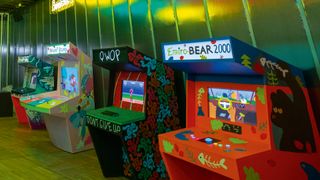
The third and final section is ‘Play’, which pivots the focus to the gaming community. “But that is not to say that this is still not a section which is telling a story of design,” Foulston says. “I think most people still perceive video games as a passive mode of consumption. But when you begin to look in detail at the way that people interact with video games today, you see them transcending the role of designer, and undertaking these massive feats of collaborative creativity.” Minecraft, unsurprisingly, has a starring role – but so does League Of Legends and the professional players who bend the competitive meta into creative new forms, as well as Overwatch and its fans’ extensions and personalisations of its characters through fanart and cosplay. Afterwards, the section shifts from the hugely popular online communities to the more niche, offline DIY arcade scene, which celebrates playable backpacks, Mitsubishi saloon cars turned into arcade cabinets and even includes Robin Baumgarten’s one-dimensional dungeon crawler Line Wobbler as a playable piece.
“It’s an exhibition that is looking to challenge people’s perceptions of video games, and to challenge their assumptions,” Foulston says. “And there is no way that this show could ever be a survey of the past 15 years of video games, but what we have brought together is this eclectic selection of diverse works that we want to show that provides a small window into what makes this period of time in game design such a radical, transformative and exciting period.”

This approach meant an altogether different – and more challenging – process of curation. Foulston and Volsing travelled to game studios all over the world to hunt down the variety of materials they knew they’d need to represent such a broad medium. “People are surprised by what we want to borrow from them,” Volsing says. “They don’t necessarily realise the interest in what they’re producing.” Foulston recalls with amusement several instances in which original concept sketches would be tugged out casually from underneath studio computers and coffee cups. “The complicated thing has been because there haven’t necessarily been those relationships between cultural institutions and designers, we’re often still trying to figure out what objects we want to borrow from them – not just physical stuff, but digital stuff where they’re like ‘What on Earth do you want to look at that for?’ So it has been a challenge, in a sense that they’ve not always known exactly what it is we’re looking for, and we’re not always sure what we’re looking for either – but you all have to go through that together.”
"Its [the exhibition's] creators began to realise the similarities between constructing this half-digital, half-physical space and designing a video game"
And then there was the question of exactly how to put all the pieces together. Foulston and Volsing found themselves overwhelmed by choice, surrounded by predominantly digital objects that they needed to display in a real space. “We felt for a long, long time that we were missing part of the curatorial arm, to realise how these objects manifest,” Foulston says. And so, through the public- sector tender process, they called for pitches from an array of agencies and designers across different disciplines. “What was different about this project was that normally the museum will look out for a designer that comes purely from an architectural background, and AV and the design and digital aspect come a little bit later on,” Foulston says. “But because of the nature of the subject, it was always understood that we needed that design expertise from the very beginning.”

The winning bid was a joint effort from production house Squint Opera and architect Pernilla Ohrstedt. The combination of AV expertise and architectural know-how would be essential to this particular exhibition: its creators began to realise the similarities between constructing this half-digital, half-physical space and designing a video game. It inspired their approach to everything. “The first major conceptual idea was to treat the exhibition as a sort of greybox space,” Ohrstedt says, “where we created the physical form before a virtual world is filled with all the colours, and music, and materials. It’s just this sort of grey ghost town where you see these intriguing images from half-finished video game worlds. So our exhibition is this kind of greybox space, and the content is the colour that sits within in, that fills and paints in the landscape.” Not only did the fragmentary nature of the broad variety of materials Foulston and Volsing had gathered began to make a beautiful kind of sense when viewed together in this context, but they could go one further: modelling the exhibition’s design on the very virtual worlds it celebrates.
Bringing famous game mechanics to life
Not that Ohrstedt and Squint Opera were about to start putting together a scale replica of Hyrule and start handing visitors swords at the door. “We’re not there to mimic it, we’re there to put forward the content of the exhibition,” she says. “But at the same time, we were inspired by certain tricks and techniques that video games use to bring a player along on this journey through a kind of game, or through levels.” At certain points in the exhibition, for instance, visitors will encounter a very familiar video game mechanic. “We’re using a kind of distance fog effect in one of the spaces in order to allow the visitor to glimpse what’s happening further down the exhibition, but then we’re introducing these fog screens in order to let you focus on what’s closest at hand,” Ohrstedt says. “That’s a technique that’s been used in video game design in order not to load too much information at once, but instead allowing hints of the landscape in the distance without taking up too much memory or capacity of the game engine.” (At this point, we’ve lost track of whether she’s referring to a PC or the human brain, and we sense that’s sort of the idea.)

Working with graphic design company Julia, meanwhile, provided another mechanical angle to explore. “You’re literally led through the exhibition through light,” Ohrstedt says. “In the same way that a door might be illuminated in a gaming level in order to draw you towards it, we’ve used the same technique to draw the visitor through the space. It directs where you’re going next, where you can get key information about the different exhibits, and helps you follow the storyline.” And it is very much a traditional linear story that Design/Play/Disrupt hopes to tell: from the curiosity and intimacy of ‘Design’, to the serious tone of ‘Disrupt’, and finally leading into the joyous, social, future-looking celebration of ‘Play’.
Were the curators and designers ever tempted to borrow from another video game trend and go open-world with their structure? “It’s something that we’ve discussed at different points,” Foulston says. “Especially with the ‘Design’ section at the beginning: how much do you allow people to navigate and find their way through?” Ohrstedt spent a lot of time assessing the wayfinding possibilities in that section of the hall, and Squint Opera’s creative director Vadim Charles the audiovisual implications of doing so. “We thought it could be interesting to have it quite open, like a playing field,” he says. “But we were a little bit worried that people would be too overwhelmed by this accumulation of moving pictures, and the sound control could have been a bit crazy, so we went for something more controlled. The challenge was to have so many games in one room at a time. It was quite an orchestrated experience, where we knew that this one’s going to be heavy on sound, and this one as well, so we’re going to put them on either end of the room.”
The exhibition as an emotional journey

The digital presentation had to agree with the physical space in order to make the experience flow naturally, which demanded close collaboration between the designers and the curators. If Foulston and Volsing were the narrative directors, the designers were tasked with engineering each emotional set- piece. According to Foulson and Volsing’s vision for the emotional journey of the exhibition, the tall, imposing space in which the ‘Design’ portion sits had to be made as intimate as it was awe-inspiring, sparking curiosity and welcoming visitors in.
Prototype footage of Journey sets the tone, shown beside the finished game to help contextualise what exactly the two blocks moving through a level are: two players working together to battle against a strong wind. “People can understand this multiplayer element, and the design of it,” Foulston says. The inclusion of the audio in the video is paramount to the atmosphere. “You actually hear the developers talking over the top and laughing as they’re playing. So you get this incredibly personal, unique insight into the designers iterating and playing with that prototype.” Charles was keen to display a portion of the finished game as a huge projection, hoping to almost put visitors in a firstperson view: “You have that character which is almost flying in the sand, and for us it was quite important to display it quite large,” he says, “to have that character on an almost human scale, so you could sort of also project yourself somehow. That’s the greatest thing with digital: you could present something on the small screen, or on a really large scale, and that’s quite nice.”

‘Disrupt’ is designed to shake visitors out of their reverie, funnelling them into a smaller space filled with huge audiovisual installations, the voices and faces of cultural commentators such as Rami Ismail and Tanya DePass on display and hoping to spark actual discussions between the people physically brought together in the space. The centralised position of this ‘Disrupt’ section is no coincidence: indeed, Foulston laughs when we point out the difference in the order of the exhibition title, having hoped that no one would really notice. In physical form, it functions best in the middle of the exhibition – ’Play’ being the grand and uplifting finale in the largest space where visitors naturally pool into a crowd, reflecting the idea of video games as a social experience on a massive scale. “But the reason why ‘Disrupt’ is at the end [of the title] is that it’s probably one of the most important points that this exhibition is making,” Foulston says. “All of the work that we’re showing is from this disruptive period. Every work is groundbreaking in different ways.”
The aim is to show just how drastically video game design has changed, and in turn affected the collective creative consciousness, in the last decade-and-a-half. “Why now?” Foulston says, repeating our question back to us. “I guess it is the urgency of the period we’re specifically looking at, but I think it is also perhaps part of the fact that we are at a tipping point of engagement of cultural institutions with the medium.” Volsing continues: “They’re so ubiquitous in our lives, digital design and video games particularly, and I think the museum realises how important it is to investigate popular culture and the way that pervades our everyday lives.” Indeed, the multiple worlds of design are now colliding more than ever before: the design of the space itself stands testament to it. “The exhibition design is very nicely representative of contemporary game design, and of design generally, and it’s really nice that the exhibition embodies that,” Foulston says.
What did the exhibition's curators learn from working so closely with video games?
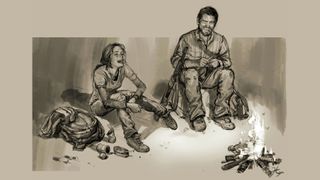
For designers Ohrstedt and Charles, working on Design/Play/Disrupt has been an opportunity to learn as they go about the significance of video games in the design story of the mid-2000s. Neither designer had any recent experience with the subject before beginning the project, and realising the parallels between their design fields and video games – and how the latter might elevate the former – has changed the way they view it entirely. Curiously enough, being so close to the design process has been a bit of a cautionary tale for Charles, whose father would rent him Atari games to play as a young child, before he decided to focus on his studies. He has “mixed feelings” about reconnecting with video games after his work on the project, perhaps due to the working knowledge he now has of the methods video games use to keep us so engrossed in a fantasy space. But he will “definitely” incorporate some of them in his future design work. “The process of the visual communication, and the style, the art direction... This is kind of what we do, somehow.”
Ohrstedt has had a similar realisation. “It’s definitely deepened my knowledge immensely, having to take in so many different video game design stories as we’ve been doing through this process,” Ohrstedt says. “It’s interesting to see how similar it is to the design of physical space. You see that in the kind of references that some of the game studios have, and where their inspiration comes from – some of it is inspiration that I look at when I design physical spaces for people to inhabit. The most eye-opening thing for me has been realising how similar the creative process actually is between designing physical space and digital space.” Will she take anything of what she’s learned while creating Design/Play/Disrupt and incorporate it into her future work? “Absolutely, yeah. Some of those tricks we’ve already introduced within the show itself, of course, but there are many others we’ll use for future spaces that we create.”

That, in essence, is the entire point, and already the exhibition’s success: that visitors with varying levels of knowledge about the subject will leave feeling inspired and enabled to create in the space they’ve just been shown. “By breaking video games down to that fundamental level of design, we’re showing people how accessible this medium actually is to engage with,” Foulston says. “We’re showing so many ways that you can actively be a designer, even through just playing a game.”
This article originally appeared in Edge Magazine. For more great gaming coverage, you can subscribe to Edge here.
Jen Simpkins is the former Editor of Edge magazine, and is a multi-award-winning creative writer. In her most recent industry role, Jen lent her immense talents to Media Molecule, serving as editorial manager and helping to hype up the indie devs using Dreams as a platform to create magical new experiences.

"I kept picturing us stranded on the side of the road with a $100k collectible game": Holy grail Castlevania buyer outlines his daring reverse heist to get the game home

Diablo 4 will "probably" get more Public Test Realms, but devs remain torn as they "take away some of the excitement" of new seasons
Most Popular




